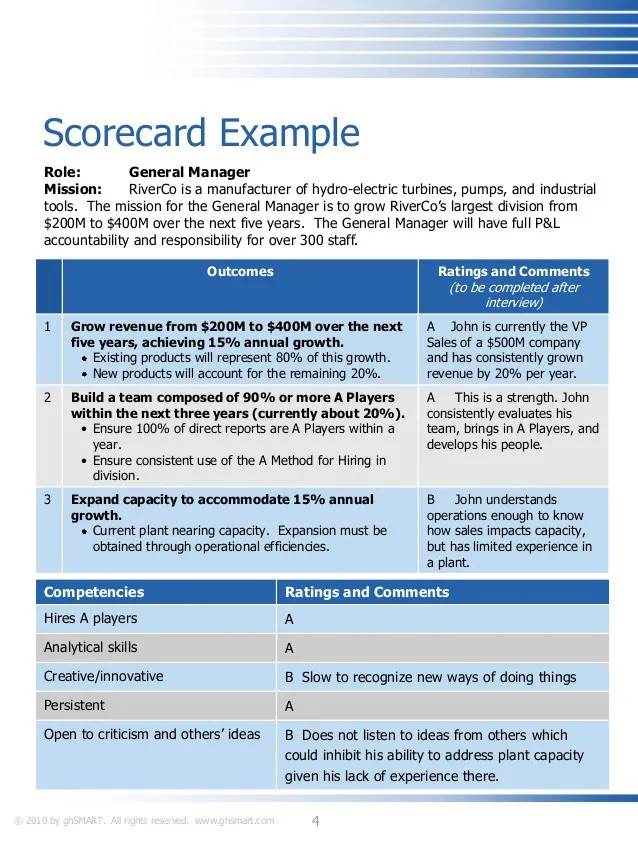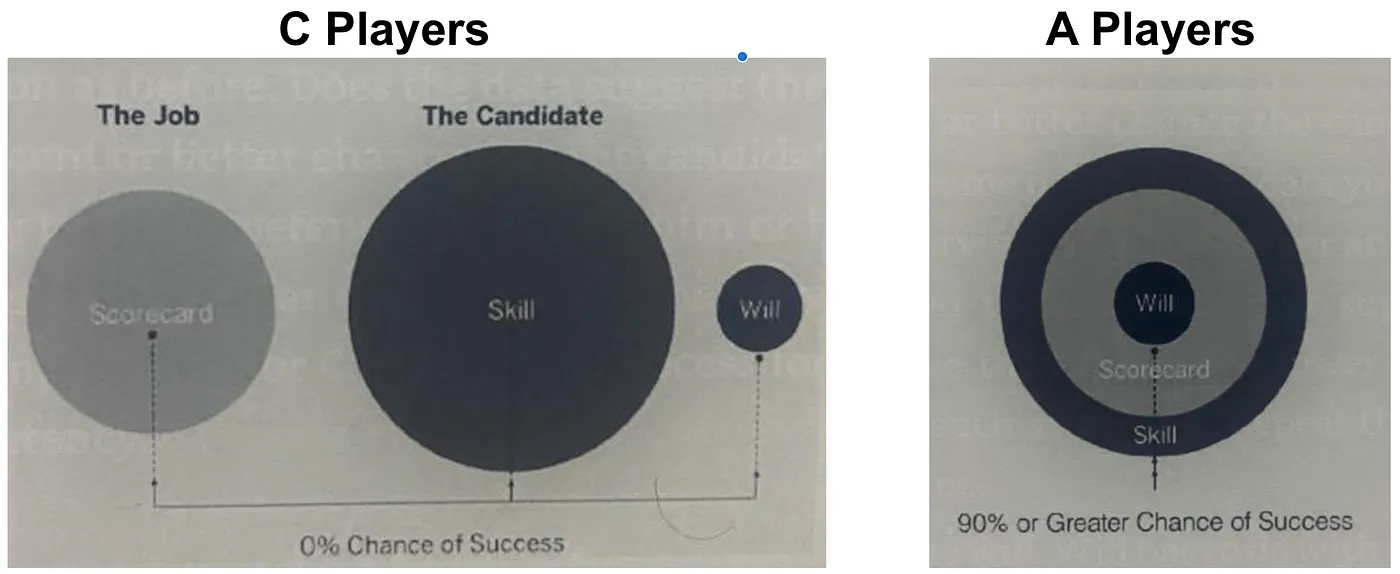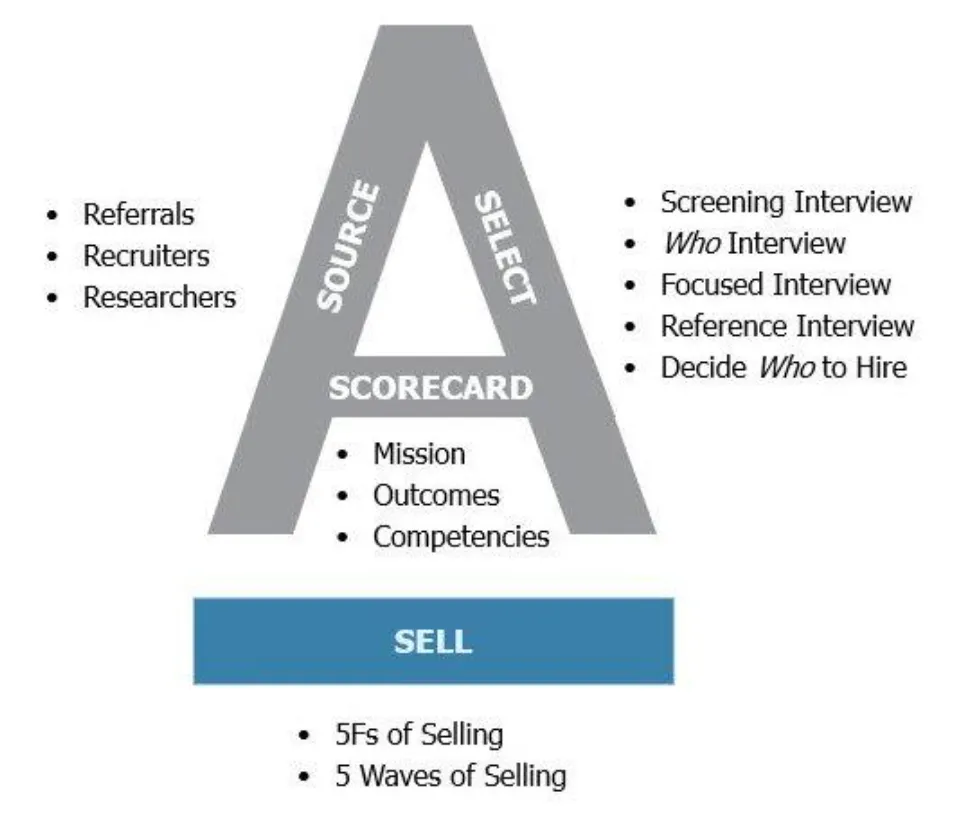Firing sucks. How to avoid doing so by hiring A players.

Firing is tough. This blogpost discusses how to avoid it by hiring A players, improving the hiring process, and understanding the importance of a scorecard in recruitment.
In 2022, OpenBB grew to 20 people. But amongst all of our hiring, we also had to let some people go.
Before 2022, I had never fired anyone in my life but in my new role, I had to learn how to do it. If you’re a manager, you know that this is the hardest part of the job.
Having that said, I wanted to use my Christmas holidays to understand how we can avoid letting people go. For this, I needed to start from the beginning and improve our overall hiring process.
This blogpost will be highly based on the book “Who: The A Method for Hiring” by Geoff Smart and Randy Street, which I highly recommend.
A method for hiring
What is an A player? _A candidate who has at least a 90 percent chance of achieving a set of outcomes that only the top 10 percent of possible candidates could achieve.
In this post, I will go over the steps to get an A team.

Scorecard
This is a document that describes the mission for the position, outcomes that must be accomplished, and competencies that fit with both the company culture and the role.
This is an example of what a scorecard should look like:

Let’s go through each of the sections in this document.
Mission
The mission is an executive summary of the job’s core purpose. It boils the job down to its essence so everybody understands why you need to hire someone in this role.
The book talks about how you should avoid hiring a generalist. In my opinion, it depends on the stage of the company. At OpenBB, we are able to ship fast with a small team because we have a lot of generalists that are A players. However, finding a generalist A player is a much harder task than finding an A player specialist. Here, we benefit from having an open source project, since we get to build with candidates before we hire them.
How to: Develop a short statement of one to five sentences that describe why a role exists.
Outcomes
Describes what a person needs to accomplish in a role.
“While typical job descriptions break down because they focus on activities, or a list of things a person will be doing, scorecards succeed because they focus on outcomes, or what a person must get done.”
How to: Develop 3 to 8 specific objective outcomes that a person must accomplish to achieve an A performance, ranked by order of importance.
Competencies
Define how you expect a new hire to operate in the fulfilment of the job and how they can achieve their objectives. What competencies really count?
Ensure behavioural fit
Critical competencies for A players are: Efficiency, honesty/integrity, organization, aggressiveness, follow-through, intelligence, analytical skills, attention to detail, persistence, proactivity.
Others may include: Ability to hire A players, ability to develop people, flexibility/adaptability, calm under pressure, strategic thinking/visioning, creativity/innovation, enthusiasm, work ethic, high standards, listening skills, openness. to criticism and ideas, communications, team work and persuasion.
Ensure organizational fit
Evaluating cultural fit begins with evaluating your company’s values against the ones of the candidate.
Recently, at OpenBB, I asked everyone to share with me a list of values that we currently had and they were proud of, and/or values that they would like to use instead. In a startup, where the pace is incredibly fast and the team is in constant change, I strongly believe values change over time. So I looked at everyone’s inputs, and summarized them into the following OpenBB values: Autonomy and Ownership, Innovation and Excellence, Transparent and Trustworthy, Diversity and Inclusion, Purpose and Passion, User Focused and Community Oriented.
How to: Identify as many role-based competencies that you think are appropriate to describe the behaviors that someone must demonstrate to achieve the outcomes. Next, identify 5 to 8 competencies that describe your culture and place those on every scorecard.
From scorecard to strategy
The beauty of a document like this is that they become the blueprint that links the theory of strategy to the reality of execution. They translate your business plans into role-by-role outcomes, create alignment among your team, unify your culture and ensure people understand your expectations.
In addition, they allow you to monitor employee progress over time in your annual review system and to rate your team as part of their talent review progress.
How to: Pressure-test your scorecard by comparing it with the business plan and scorecards of the people who will interface with the role. Ensure that there is consistency and alignment. Then share the scorecard with relevant parties, including peers and recruiters.
Source
Systematic sourcing before you have slots to fill ensures you have high-quality candidates waiting when you need them.
Referrals from your professional and personal networks
Create a list of the ten most talented people you know and commit to speaking with at least one of them per week for the next ten weeks. At the end of each conversation ask “Who are the most talented people you know?”. Continue to build your list and continue to talk with at least one person per week. “Of all the ways to source candidates, the number one method is to ask for referrals from your personal and professional networks”.
Referrals from your employees
Add sourcing as an outcome on every scorecard for your team. Encourage employees to ask people in their networks. Offer a referral bonus. In-house referrals often provide better-targeted sourcing, this is because employees already know our needs and culture.
Deputizing friends of the firm
Consider offering a referral bounty to select friends of the firm. It could be as inexpensive as merchandise or as expensive as a significant cash bonus. When talking with someone new at a party or a VC, always ask “who do you know who might be a good fit for my company?”
Sourcing system
Create a system that (1) captures the names and the contact information on everybody you source and (2) schedules weekly time on your calendar to follow up. Try to spend 30 minute every week sending messages or having calls with candidates from this database of A players.
Hiring external recruiters or hiring recruiting researchers
The book speaks about both, but from my experience of having an open company with an exciting mission that builds in public, these have not been relevant to us yet.
Select
Create a series of structured interviews which build on each other so you can rate your scorecard.
Screening Interview
Short, phone-based interview designed to clear out B and C players from your roster of candidates.
-
What are your career goals? If no goals echo your own website goals, screen them out. Ideally candidate will speak with passion and energy about their goals which are aligned with the role.
-
What are you really good at professionally? Make sure that with the list of strengths, there are always examples to backup the claim. Ensure that those strengths are relevant to the competencies required in the scorecard, if not, screen them out.
-
What are you not good at or not interested in doing professionally? Ignore strengths disguised as weakness. Ask again “what are you really not good at or not interested in doing?”, talented people will catch the hint. If you’re still struggling to get a proper answer, put the fear of a reference check into the person — “if you advance to the next step in our process, we will ask for your help in setting up some references. (…) What would these references say are something things you are not good at or not interested in?”
-
Who were your last five bosses, and what would they each rate your performance on a scale of 1–10 WHEN we talk to them? The word ‘when’ is the key to unlock the truth. A rating of 7 is neutral, we are looking for 8 and above. After the rating answer always press for details.
If you are happy with the interview so far, conclude the call by offering the candidate an opportunity to ask questions. Otherwise just thank them for their time.
Tips:
- Always compare the person’s strengths with the ones on the scorecard.
- When in doubt, there’s no doubt. You need to have the feeling that you have found the one.
- Get curious: What, How, Tell me more. Keep using this framework until you are clear about what the person is really saying.
- Hit the gong fast. If an answer automatically rules out a candidate, just end up the interview earlier and use your precious time to focus on A players.
Who to Interview
Chronological walk-through of a person’s career.
You can begin by asking about the highs and lows of a person’s educational experience to gain insight into their background. After this, ask them 5 simple questions for each job they had in the past.
What were you hired to do?
You are trying to discover what their scorecard might have been if they had one for that role. Ask them “how was your success measured in the role? What was the mission and key outcomes? What competencies mattered?”.
What accomplishments are you most proud of?
Ideally, candidates will tell you about accomplishments that match the job outcomes they just described to you. Even better if they match the ones of the scorecard for the position you are trying to fill.
Note: A players tend to talk about outcomes linked to expectations, B and C players talk generally about events, people they met, or aspects of the job they liked without ever getting into results.
What were some of the low points during that job?
People can be hesitant to share their lows at first. Keep reframing the question over and over until the candidate gets the message. E.g. “What went really wrong? Biggest mistake? done differently? parts you didn’t like? peers stronger than you?”
Who were the people you worked with?
- What was your boss’s name and how do you spell that?
Forcing candidates to spell the name out no matter how common it might be sends a powerful message: you are going to call, so they should tell the truth. This is referred as the “threat of reference check (TORC)”.
- What was it like working with them?
Ideally, you expect high praise for their bosses and how they received mentoring and coaching from them over the years. A neutral answer will sound somewhat more reserved — not positive nor negative.
- What WILL they tell me about your biggest strengths and areas to improve?
Use “will” instead of “would” so candidates know you mean business, and are therefore, more likely to tell you the truth since you will learn it from reference calls anyways. Dig in as much as you can.
- How would you rate the team you inherited on an A, B, C scale? What changes did you make? Did you hire anybody? Fire anybody? How would you rate the team when you left it on A,B,C scale.
This is applicable to managers. And allows you to understand how they approach building a strong team. Do they accept the hand they have been dealt with or do they make changes to make a better hand? What changes do they make? How long does it take?
Apply TORC here too: “When we speak with team members of your team, what will they say were your biggest strengths and weaknesses as manager?”
Why did you leave that job?
Was the candidate promoted, recruited or fired from each job? How did they feel about it? How did their boss react to the news? E.g. A players are highly valued by their bosses.
Get curious. Find out why and stick with it until you have a clear picture of what actually happened.
Conducting an effective who interview
- The hiring manager should conduct this interview. They own the hire, and are the ones who will suffer the consequences of making a mistake. Their career and job happiness depend on finding A players.
- Conduct an interview with a colleague (e.g. someone from HR, another manager or member of your team), this allows you to focus on questions and someone else to take notes.
- Kick off the interview by setting expectations, e.g. “We are going to walk through each job you have held, for each job I am going to ask you five core questions. At the end we will discuss your career goals and aspirations and you will have a chance to ask me questions. If we mutually decide to continue, we will conduct reference calls to complete the process”.
Master tactics
- Interrupting. You have to interrupt the candidate, there is no avoiding it. At least once every 3/4 minutes. Smile broadly, match their enthusiasm level, and use reflective listening to get them to stop talking without demoralizing them.
- The three P’s. This helps you understand how valuable an accomplishment was in any context. (1) How did the performance compare to the previous year’s performance; (2) How did your performance compare to the plan?; (3) How did your performance compare to that of peers?
- Push versus Pull. People who perform are generally pulled to greater opportunities. People who perform poorly are often pushed out of their jobs.
- Painting a picture. You’ll only understand what a candidate is saying when you can literally see a picture of it in your mind. Always try to put yourself in their shoes.
- Stopping at the Stop signs. Look for shifts in body language and other inconsistencies. “We did great in that role” while shifting in their chair, looking down and covering their mouth may be a stop sign. When that happens, get curious and understand how “great” they actually did. What was actually their contribution?
Focused Interview
Getting to know more. This is NOT another Who interview. It provides the chance to invite other team member to get their opinion, but the script should be followed. Think of this interview as the “odds enhancer” to truly focus on the outcomes and/or competencies on the scorecard.
- The purpose of this interview is to talk about [specific outcome or competency]
- What are your biggest accomplishments in this area during your career
- What are your insights into your biggest mistakes and lessons learned in this area?
Don’t be scared to use the “What? How? Tell me more” framework until you understand what the person did and how they did it.
Feel free to have multiple shorter focused interviews to understand particular outcome/competencies.
Double-check the cultural fit. Final gauge on the cultural fit — critical! Include competencies and outcomes that go beyond the specifics of the job to embrace the larger values of your company.
Reference Interview
Testing what you learned. Don’t skip the references!
- Pick the right references. Review your notes from the Who interview and pick the bosses, peers, and subordinates with whom you would like to speak. Don’t just use the reference list the candidate gives you.
- Ask the candidate to contact the references to set up the calls. Some companies have a policy that prevents employees from serving as references, so you can increase your chances of talking with a reference if the candidate sets this up.
- Conduct the right number of reference interviews. The book recommends 3 past bosses, 2 peers/customers and 2 subordinates.
Reference interview guide:
- In what context did you work with the person? Conversation starter and memory jogger.
- What were the person’s biggest strengths? Ask for multiple examples to put strengths and development areas into context. Don’t forget to get curious by using “What? How? Tell me more” framework to clarify responses.
- What were the person’s biggest areas for improvement back then? The wording ‘back then’ liberates the reference to talk about weaknesses that existed in the past. “In truth, we believe, people don’t change that much. People aren’t mutual funds. Past performance really is an indicator of future performance.”
- How would you rate their overall performance in that job on a 1–10 scale? What about their performance causes you to give that rating? Remember that 6 is really a 2. How does this rating compare with what the candidate said in advance? Wide discrepancy is alarming.
- The person mentioned that they struggled with ____ on that job. Can you talk more about that? Test something the candidate told you by framing it as a question for the reference. E.g. “the person mentioned that you MIGHT SAY he was disorganized. Can you tell me more about that?” the wording is again very important as ‘might say’ suggests to the reference that they have permission to talk about the subject because the candidate raised it.
These questions follow the same pattern as the other interviews. This makes it very easy to merge what you hear with what you have already learned about a candidate.
Tips:
- Avoid accepting a candidate’s reference list at face value. E.g. either use your own network for gathering objective unbiased data or try to reach out to subordinates or people two levels below who interacted with the candidate to get a more honest answer.
- Hearing or understanding the code for risky candidates. Be able to read between lines. People don’t like to give negative reference, so your best defense is to pay close attention to what people say and how they say it. Examples of bad signs: If they just confirm dates of employment, um’s and er’s is hesitation, absence of enthusiasm (faint praise).
Decide who to hire
Skill-Will Bull’s Eye
Does somebody’s skill (what they can do) and will (what they want to do) match your scorecard? This is a person’s skill-will profile.

You should have plenty of data at this stage to make this assessment.
- Skill has to do with a candidate’s ability to achieve the individual outcomes on your scorecard. If you believe a candidate has a 90% or better chance to achieve a certain outcome based on the data gathered, rate them an A, otherwise a B or a C. Repeat for each outcome.
- Will has to do with the motivations and competencies a candidate brings to the table. For each competency, does the data suggest there is a 90% or better chance that the candidate will display that competency? If so rate them an A, otherwise a B or C. Repeat for each competency.
An A player is someone whose skill and will match your scorecard. Anything less is a B or C, no matter the experience or seeming talent level.
Red Flags: When to dive beneath the surface
These flags may not be deal killers, but they are likely to signal that there is something worth exploring beneath the surface:
- Does not mention past failures
- Exaggerates their answers
- Takes credit for the work of others
- Speaks poorly of past bosses
- Cannot explain job moves
- People most important to the candidate are unsupportive of a change
- For managerial hires, never had to hire or fire anybody
- Seems more interested in compensation and benefits than in the job itself
- Tries too hard to look like an expert
- Self-absorbed
More behavioral warning signs:
- Winning too much
- Adding too much value
- Starting a sentence with ‘no’, ‘but’, or ‘however’
- Telling the world how smart we are
- Making destructive comments about previous colleagues
- Blaming others
- Making excuses
- The excessive need to ‘be me’
How to decide:
- Take out your scorecards that you have completed on each candidate
- Make sure you have rated all of the candidates on the scorecard. If you have not given each candidate an overall A, B or C grade, do so now. Make any updates you need to based on the reference interviews. Look at the data, consider the opinions and observations of the interview team, and give a final grade.
- If you have no A’s, then restart your process and the second step: source.
- If you have one A, decide to hire that person.
- If you have multiple A’s, then rank them and decide to hire the best A among them.
Sell
Once candidates pass the selection, persuade them to join. The key to successfully selling your candidate to your company is putting yourself in their shoes.
Five F’s of selling
There are 5 areas that candidates tend to care about, make sure to address each of these 5 areas until you get the person onboard.
- Selling Fit: This ties together the company’s vision, needs and culture with the candidate’s goals, strengths and values.
- Selling Family: Takes into account the broader trauma of changing jobs.
- Selling Freedom: The autonomy the candidate will have to make their own decisions.
- Selling Fortune: Reflects the stability of your company and the overall financial upside.
- Selling Fun: Describes the work environment and personal relationships the candidate will make.
Five waves of selling
Selling should be something that happens throughout the entire hiring process. In particular, there are five distinct phases that merit increased selling effort:
- When you source
- When you interview
- The time between your offer and the candidate acceptance
- The time between the candidate’s acceptance and their first day
- The new hire’s first one hundred days on the job
Persistent pays off
Once you have identified the right candidate, you must be persistent and do whatever you can to sign the deal.
How to: sell A Players
- Identify which of the five F’s really matter to the candidate.
- Create and execute a plan to address the relevant F’s during the five waves of selling.
- Be persistent. Don’t give up until you have your A player on board.
Conclusion
In a more simplistic image, this is what the A method boils down too.

I really enjoyed reading this book and I am taking a lot of these learnings to improve the hiring processes at OpenBB.